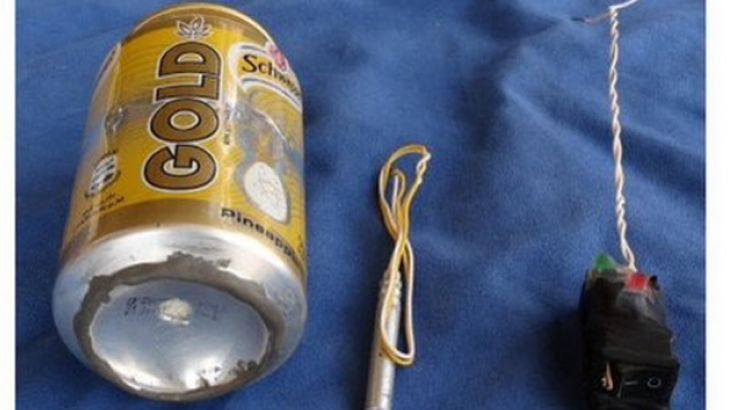Could a bomb in a soda can really bring down a plane?
Experts weigh-in on whether ISIL’s claim to have used a can of Schweppes to destroy Russian airliner is credible.

The Islamic State of Iraq and the Levant (ISIL) made the headline-grabbing claim on Wednesday that it used explosives hidden in a can of Schweppes soda to down a Russian airliner over Egypt’s Sinai.
The revelation, carried in its English-language online magazine Dabiq, was accompanied by a photograph purporting to show the device used last month to kill all 224 people onboard the Metrojet flight.
Keep reading
list of 4 itemsMoscow theatre attack suspects show signs of beating in court
Four men showing signs of severe beating charged over Moscow concert attack
Russia mourns Moscow concert hall attack victims as death toll rises to 137
When a bomb detonates on an aircraft, all you have to do is punch a hole in the side of an aircraft large enough to create an explosive decompression and the plane actually blows itself up.
There was the can, and what looked like a detonator and a switch.
But could such crude-looking materials – in such a small package – be enough to break up an Airbus A321 typically weighing at least 70 tonnes?
Some experts told Al Jazeera that, based on the photo alone, ISIL’s claim was credible.
“Inside the can itself – if filled to full capacity – there are probably 200 to 300 grammes of high explosives. So certainly it’s a viable device,” Chris Hunter, an explosives expert, said.
“And certainly if placed in the optimal position, it could potentially destroy the aircraft and cause catastrophic failure.”
Hunter said that at 30,000 feet (which is more than nine kilometres) above sea level, a breach in the shell of the aircraft would cause it to completely disintegrate.
Russia said on Tuesday that it believed a bomb was to blame for the crash, a conclusion several Western governments had already reached. President Vladimir Putin has offered a $50m reward for information leading to the capture of those who destroyed the jet.
“Keep in mind that when a bomb detonates on an aircraft, all you have to do is punch a hole in the side of an aircraft large enough to create an explosive decompression and the plane actually blows itself up,” Douglas Laird, an aviation security consultant, told Al Jazeera.
“A bomb just starts the process,” he said.
“Based on the appearance in the photo, I don’t believe the device was in luggage. I believe the device was in the passenger compartment.”
‘Security loophole exploited’
But Neal Langerman, a chemical safety consultant based in San Francisco, told Al Jazeera that the photo published by ISIL does not provide much evidence as to how the plane crashed.
“We cannot make assumptions based on a photo. We do not even know if this was really the device that was used. We will have to wait for the Russians to provide forensic evidence,” Langerman said.
ISIL, which controls large areas of Iraq and Syria and has a powerful affiliate in the Sinai region, also said it had exploited a loophole at Sharm al-Sheikh airport to smuggle the bomb onboard.
The group’s claims raise difficult questions for Egypt about the security of its airports, though Cairo has not yet said why it believes the plane crashed or if there was indeed a lapse at Sharm al-Sheikh.
Two members of the ground crew were reported by local media to have been detained for questioning.
“It tells you a lot that ISIL can operate away from Syria and Iraq and away from northern Sinai where the bulk of the insurgency is going on, because the operation happened in southern Sinai,” Egyptian political and security analyst Omar Ashour told Al Jazeera.
With reporting by Basma Atassi.